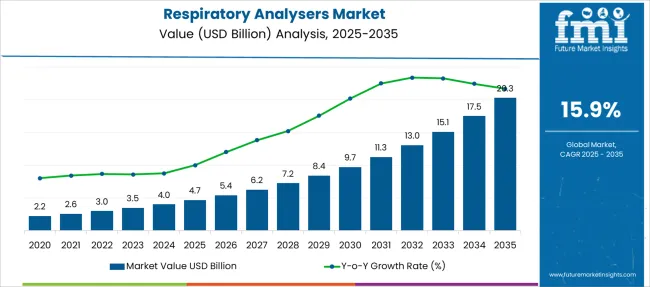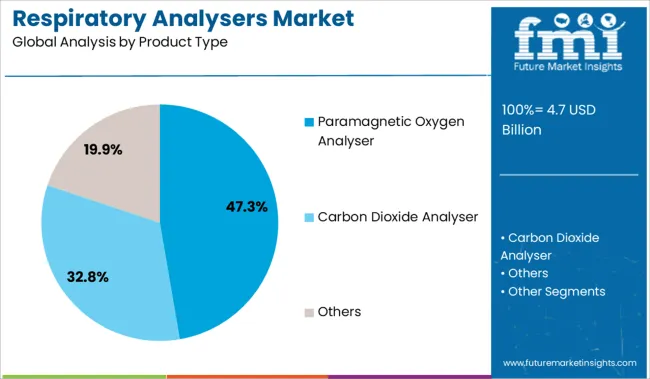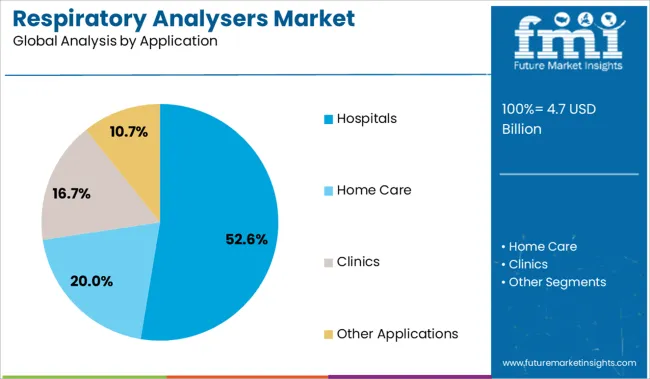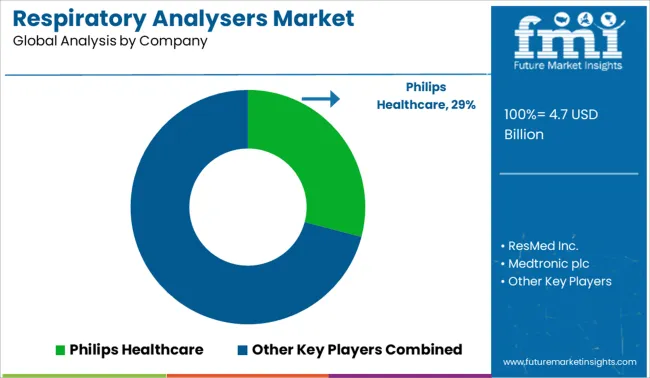The Respiratory Analysers Market is estimated to be valued at USD 4.7 billion in 2025 and is projected to reach USD 20.3 billion by 2035, registering a compound annual growth rate (CAGR) of 15.9% over the forecast period.

| Metric | Value |
|---|---|
| Respiratory Analysers Market Estimated Value in (2025 E) | USD 4.7 billion |
| Respiratory Analysers Market Forecast Value in (2035 F) | USD 20.3 billion |
| Forecast CAGR (2025 to 2035) | 15.9% |
The respiratory analysers market is expanding due to the increasing global prevalence of respiratory disorders, rising adoption of precision diagnostics, and growing awareness surrounding patient monitoring in critical care settings. The demand for accurate and continuous gas analysis is accelerating across clinical environments, especially in the management of chronic obstructive pulmonary disease, asthma, and post operative care.
Hospitals and healthcare providers are prioritizing devices that ensure real time respiratory monitoring and oxygen concentration control. Technological advancements in sensor accuracy, compact design, and automated calibration are further strengthening market adoption.
Additionally, the shift toward value based care and early disease detection is promoting the use of respiratory analysers in preventive health frameworks. As healthcare systems continue to scale intensive care capabilities and upgrade diagnostic infrastructure, the market is projected to maintain a strong growth trajectory supported by clinical need and technological innovation.
The market is segmented by Product Type and Application and region. By Product Type, the market is divided into Paramagnetic Oxygen Analyser, Carbon Dioxide Analyser, and Others. In terms of Application, the market is classified into Hospitals, Home Care, Clinics, and Other Applications. Regionally, the market is classified into North America, Latin America, Western Europe, Eastern Europe, Balkan & Baltic Countries, Russia & Belarus, Central Asia, East Asia, South Asia & Pacific, and the Middle East & Africa.

The paramagnetic oxygen analyser segment is projected to account for 47.30% of total market revenue by 2025 within the product type category, making it the leading segment. This prominence is attributed to its high measurement precision, rapid response time, and long term operational stability.
These analysers are widely used in clinical settings where accurate oxygen concentration monitoring is critical, such as intensive care units, operating rooms, and pulmonary diagnostics. Their non consumable nature, low maintenance requirements, and ability to deliver continuous real time data have contributed to widespread adoption.
As healthcare providers demand more reliable and consistent respiratory monitoring tools, paramagnetic oxygen analysers have emerged as the preferred choice due to their performance reliability and cost effectiveness over the device lifecycle.

The hospitals segment is expected to hold 52.60% of total market revenue by 2025 under the application category, making it the dominant end use sector. This leadership is driven by the high volume of respiratory procedures, need for critical care monitoring, and the demand for precise gas analysis during anesthesia and ventilation.
Hospitals require integrated monitoring systems that deliver accurate oxygen and gas concentration readings in real time to support patient safety and treatment efficacy. Additionally, the rise in surgical interventions and increasing number of hospital admissions related to respiratory conditions have intensified the need for advanced analyser systems.
Continuous infrastructure upgrades and investments in modernizing clinical diagnostics are also reinforcing the strong presence of hospitals in the respiratory analysers market.
Sales of respiratory analyzers are projected to propel owing to growing premature birth rates, growing urbanization, increase in pollution, smoking culture, and lifestyle modification. The production of respiratory equipment has been under pressure to innovate due to the increased prevalence of respiratory disorders. Analyzers and other respiratory devices are now more widely used as a result of patients with COPD (Chronic Obstructive Pulmonary Disease) and asthma seeking more precise drug therapy.
Some other factors increasing the demand for respiratory analyzers are:
Over the forecast period, rising healthcare expenditure, emphasis on medical tourism in emerging economies, and the growing need for these medical devices to tap potential are projected to propel the expansion of the global respiratory analysers market and strengthen growth opportunities for the key market players.
The increased demand for therapeutic respiratory devices in home healthcare applications is one important aspect that is projected to generate growth opportunities over the forecast period. In recent years, home healthcare devices have gained recognition and market share.
As the adoption rate of respiratory analyzers keeps increasing, the market for these devices is anticipated to experience profitable opportunities. The respiratory analysers market is also anticipated to develop as a consequence of the increased emphasis on projects by private and governmental organizations to manufacture nanotechnology items that may be used in conjunction with medical equipment.
To attain a competitive advantage market players are making numerous technological developments, such as the invention of product versions that can be linked to Bluetooth for personalized tracking and analyzers integrated with fuel cell and semiconductor sensor technologies to deliver more precise findings.
Another area of interest for both well-established industry players and other developing players is the development of therapeutic respiratory equipment for home healthcare. For example, Movair, a respiratory therapy company formerly known as International Biophysics Corporation, officially confirmed the USA commercial advent of Luisa in October 2024.
Luisa is a novel ventilator that is intended for use in homes, healthcare facilities, and other institutions as well as portable applications for both invasive and noninvasive airflow.
At present, North America is the leading global respiratory analyser market. As per the WHO, chronic obstructive pulmonary disease (COPD) is expected to be the 3rd leading cause of global deaths. According to the National Sleep Foundation, 40 million Americans suffered from insomnia or some other form of chronic sleep disorders.
There are many cases of both COPD and Asthma reported there. While North America leads these statistics, Europe is second in terms of the people complaining of respiratory ailments.The key respiratory analyser market to focus on for long-term growth would be the APAC region.
It is undergoing rapid modernization, with little to no concern for environmental or biological factors, thus giving rise to health issues for its citizens. Increasing focus on medical programs and awareness, both from the government and the private sector all point to a bright future for this market. Hospitals form the largest end users of respiratory analysers and they are also expected to record the highest growth rate.
Any equipment which serves a specialised function tends to be expensive and this holds true for the Respiratory Analysers Market as well. The high cost is such a detriment that customers hesitate purchasing modern equipment and prefer using the old, archaic ones.
Even lack of awareness in underdiagnosed, undertreated poorer countries can be a major impediment to growth. Along with this, the installation and usage of such advanced respiratory analysers requires highly skilled professionals, who are in short supply in these nations.
Another issue is the saturation in developed countries due to the oligopolistic market situation. Hence, there are moderate to high barriers for entry for new players seeking to enter this market, thereby limiting competition and customer choice.
The Respiratory Analysers Market can be divided into five key regions viz. North America, Europe, Asia Pacific, Latin America and the Middle East and North Africa. (MENA) North America is the largest market at present and is expected to remain so for the near future.
The fastest growing market for this is unquestionably the Asia- Pacific region. China and India are the fastest growing major economies in the world. Their large populations, increasing government attention towards healthcare, booming medical tourism in them and Southeast Asian nations like Thailand will ensure continued demand for products sold in the respiratory analyser market.
Key players would also be advised to look at Latin America to provide ample growth opportunities in the years to come.

The main manufacturers in the Respiratory analyser market include globally renowned companies like Smiths Medical (UK), Philips Healthcare (Netherlands), ResMed, Inc. (USA), Covidien plc (Ireland), Masimo Corporation (USA), Fisher and Paykel Healthcare Limited (New Zealand), and CareFusion Corporation (USA).
The research report presents a comprehensive assessment of the market and contains thoughtful insights, facts, historical data, and statistically supported and industry-validated market data. It also contains projections using a suitable set of assumptions and methodologies.
The research report provides analysis and information according to market segments such as geographies, types and applications.
The global respiratory analysers market is estimated to be valued at USD 4.7 billion in 2025.
The market size for the respiratory analysers market is projected to reach USD 20.3 billion by 2035.
The respiratory analysers market is expected to grow at a 15.9% CAGR between 2025 and 2035.
The key product types in respiratory analysers market are paramagnetic oxygen analyser, carbon dioxide analyser and others.
In terms of application, hospitals segment to command 52.6% share in the respiratory analysers market in 2025.






Full Research Suite comprises of:
Market outlook & trends analysis
Interviews & case studies
Strategic recommendations
Vendor profiles & capabilities analysis
5-year forecasts
8 regions and 60+ country-level data splits
Market segment data splits
12 months of continuous data updates
DELIVERED AS:
PDF EXCEL ONLINE
Respiratory Trainer Market Size and Share Forecast Outlook 2025 to 2035
Respiratory Distress Syndrome Management Market Size and Share Forecast Outlook 2025 to 2035
Respiratory Protective Equipment Market Size and Share Forecast Outlook 2025 to 2035
Respiratory Measurement Devices Market Size and Share Forecast Outlook 2025 to 2035
Respiratory Heaters Market Trends and Forecast 2025 to 2035
Respiratory Pathogen Testing Kits Market Insights - Growth & Forecast 2025 to 2035
Respiratory Inhaler Devices Market Report – Size & Forecast 2025-2035
Understanding Market Share Trends in Respiratory Inhaler Devices
Respiratory Gating Market Analysis – Size, Share & Forecast 2025-2035
Respiratory Device Market Insights – Growth & Forecast 2024-2034
Global Respiratory Biologics Market Analysis – Size, Share & Forecast 2024-2034
Home Respiratory Therapy Market – Growth & Forecast 2025 to 2035
Japan Respiratory Inhaler Devices Market Size and Share Forecast Outlook 2025 to 2035
Swine Respiratory Diseases Treatment Market Analysis - Size and Share Forecast Outlook 2025 to 2035
Human RSV Treatment Market Insights - Innovations & Forecast 2025 to 2035
Upper Respiratory Tract Infection Treatment Market
Germany Respiratory Inhaler Devices Market Insights – Demand, Trends & Outlook 2025-2035
Chronic Respiratory Diseases Treatment Market
Molecular Respiratory Panels Market Size and Share Forecast Outlook 2025 to 2035
Unit-Dose Respiratory Medications Market

Thank you!
You will receive an email from our Business Development Manager. Please be sure to check your SPAM/JUNK folder too.
Chat With
MaRIA